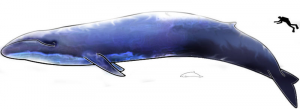Did you know that whales are the largest animals to have ever lived on earth? Yes, these gigantic mammals are even larger than any known dinosaur!

This image showing how much larger whales are than humans. Source https://commons.wikimedia.org/wiki/File:Image-Blue_Whale_and_Hector_Dolphine_Colored.jpg?fbclid=IwAR29H5Kb6uE3ePxNld25HhObWwaaTG4jAbB9Fr_pww4F_LKh3S3dSK53tJw
WHALE JAW STRUCTURE
But how are whales able to feed underwater without being injured by the heavy flows of water and pressure they face within our great oceans? Well, Dr. Shadwick from the University of British Columbia (UBC) and his research team investigated the structural and mechanical properties of the whale mandible (lower jaw) in adult rorqual whales (humpback, fin, minke and blue whales). Dr. Shadwick and his team were trying to determine where the immense pressure and load is absorbed when these massive creatures swallow 5,000 gallons of water filled with shrimp, krill and phytoplankton.
Our podcast is discussing the structure of jaw in whales. Made by Group 210-6 and it is posted on Youtube https://youtu.be/NoNDhSnRAcA.
During feeding a whale lowers its lower jaw to extreme angles and swims very quickly which causes drag force of the water to expand the mouth opening more. Ultimately, the whale will engulf a volume of water larger than itself. The mechanical and structural properties of the expansion of the lower jaw are due to combination of high bone density and large area of the bone which prevents the bone from bending and breaking. Also, Dr. Shadwick and his team discovered the compact bone layer within the lower jaw is the main load bearing element.
Our video is discussing how whales are helping ocean ecosystems by moving nutrients and providing marine animals with a habitat. Source Group 210-6 and it is posted on Youtube https://youtu.be/5WkRYSSYZNk.
Now, we know that whales have an elastic lower jaw, which is made of highly dense and compacted bone layers that allow whales to withstand immense pressure and forces of water when feeding.
Video of a blue whale feeding on a pool of krill by opening its mouth to extreme angles. Source of video is National Geographic that was published on Youtube.
WHALES VS. PELICANS
However, are whales the only animals with an elastic lower jaw? Well, the answer is no because pelicans have evolved a similar body part too!

This image is showing a pelican flying over the ocean. Source https://commons.wikimedia.org/wiki/File:Pelikan_Walvis_Bay.jpg?fbclid=IwAR3FeUOZXeIyvgO9gawmPO3gIe6gRmJvijoYoKXLReEm_chNy5TvPLfS9Eg
Both, whales and pelicans have independently evolved similar elastic lower jaws and engulf their prey by swallow large volume of water. Both, their jaws consists of stretchy and elastic tissue resulting in the mouth to open almost 80 degrees. Furthermore, whales are able to swallow 50% of their total body volume whereas, pelicans can swallow 300% of their total body volume. Their lower jaws consists of an elastic pouch that holds the gallons of water with their prey. In whales this elastic pouch is called a ventral groove blubber whereas, in pelicans is it called the gular sac. Therefore, whales and pelicans are great examples of convergent evolution, when two not closely related lineages evolve similar traits due to adapting to similar environments. Both, their lower jaws withstand great amounts of pressure by allowing compacted bone layers to absorb the pressure and forces. Also, their lower jaws resistant the stress of bending in similar ways too.
Both, these toothless creatures have evolved similar jaw structures consisting of elastic and stretchy components which allows them to swallow large volumes of water without breaking and fracturing their jaws.
Group 210-6: Austin Chang, Sabrina Cheema, Emonil Dong, and Austin Tang
